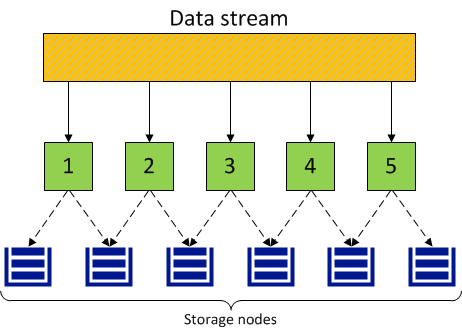2.6. Understanding data redundancy¶
Acronis Cyber Infrastructure protects every piece of data by making it redundant. It means that copies of each piece of data are stored across different storage nodes, to ensure that the data is available even if some of the storage nodes are inaccessible.
Acronis Cyber Infrastructure automatically maintains a required number of copies within the cluster and ensures that all the copies are up to date. If a storage node becomes inaccessible, copies from it are replaced by new ones that are distributed among healthy storage nodes. If a storage node becomes accessible again after downtime, the out-of-date copies on it are updated.
The redundancy is achieved by one of two methods: replication or erasure coding (this is explained in more detail in the next section). The chosen method affects the size of one piece of data and the number of its copies that will be maintained in the cluster. In general, replication offers better performance, while erasure coding leaves more storage space available for data (see the table).
对于每种冗余方法,Acronis Cyber Infrastructure 都支持多种模式。下表显示了各种冗余模式的数据开销。前三行是复制,其余的是擦除编码。
冗余模式 |
要求的最小节点数 |
多少节点可以发生故障而不丢失数据 |
Storage overhead, percent |
存储 100GB 数据所需的原始空间 |
|---|---|---|---|---|
1 个副本(无冗余) |
1 |
0 |
0 |
100 GB |
2 个副本 |
2 |
1 |
100 |
200 GB |
3 个副本 |
3 |
2 |
200 |
300 GB |
编码 1+0(无冗余) |
1 |
0 |
0 |
100 GB |
编码 1+1 |
2 |
1 |
100 |
200 GB |
编码 1+2 |
3 |
2 |
200 |
300 GB |
编码 3+1 |
4 |
1 |
33 |
133 GB |
编码 3+2 |
5 |
2 |
67 |
167 GB |
编码 5+2 |
7 |
2 |
40 |
140 GB |
编码 7+2 |
9 |
2 |
29 |
129 GB |
编码 17+3 |
20 |
3 |
18 |
118 GB |
注解
The 1+0, 1+1, 1+2, and 3+1 encoding modes are meant for small clusters that have insufficient nodes for other erasure coding modes but will grow in the future. As a redundancy type cannot be changed once chosen (from replication to erasure coding or vice versa), this mode allows you to choose erasure coding even if your cluster is smaller than recommended. Once the cluster has grown, more beneficial redundancy modes can be chosen.
You choose a data redundancy mode when configuring storage services and creating storage volumes for virtual machines. No matter what redundancy mode you choose, it is highly recommended to be protected against a simultaneous failure of two nodes, as that happens often in real-life scenarios.
当一个存储节点不可访问时,所有冗余节点都允许写操作。如果两个存储节点不可访问,写操作可能会冻结,直到簇修复自身。
2.6.1. Redundancy by replication¶
With replication, Acronis Cyber Infrastructure breaks the incoming data stream into 256 MB chunks. Each chunk is replicated and replicas are stored on different storage nodes, so that each node has only one replica of a given chunk.
下图显示了两个副本的冗余模式。

Replication in Acronis Cyber Infrastructure is similar to the RAID rebuild process, but has two key differences:
Acronis Cyber Infrastructure 中的复制比典型的在线 RAID 1/5/10 重建的复制要快得多。原因是 Acronis Cyber Infrastructure 将区块并行复制到多个存储节点。
簇中的存储节点越多,簇从磁盘或节点故障中恢复的速度就越快。
高复制性能会最大程度地缩短减少的簇冗余的周期。复制性能受以下因素影响:
The number of available storage nodes. As the replication runs in parallel, the more available replication sources and destinations there are, the faster it is.
存储节点磁盘的性能。
Network performance. All replicas are transferred between storage nodes over network. For example, 1 Gbps throughput can be a bottleneck (refer to Per-node network requirements and recommendations).
簇中数据的分布。某些存储节点可能比其他节点有更多数据,而且可能在复制期间变得超负荷。
复制期间簇的 I/O 活动。
2.6.2. Redundancy by erasure coding¶
With erasure coding, Acronis Cyber Infrastructure breaks the incoming data stream into fragments of a certain size, then splits each fragment into a certain number (M) of 1-megabyte pieces and creates a certain number (N) of parity pieces for redundancy. All pieces are distributed among M+N storage nodes, that is, one piece per node. On storage nodes, pieces are stored in regular chunks of 256 MB but such chunks are not replicated as redundancy is already achieved. The cluster can survive failure of any N storage nodes without data loss.
The values of M and N are indicated in the names of erasure coding redundancy modes. For example, in the 5+2 mode, the incoming data is broken into 5 MB fragments, each fragment is split into five 1 MB pieces and two more 1 MB parity pieces are added for redundancy. In addition, if N is 2, the data is encoded using the RAID6 scheme, and if N is greater than 2, erasure codes are used.
下图显示 5+2 模式。

2.6.3. No redundancy¶
警告
有数据丢失的危险!
若没有冗余,单数的区块存储在存储节点上,每个节点一个。如果节点发生故障,可能丢失数据。不管是哪种场景,都不建议无冗余,除非只是想在单个服务器上评估 Acronis Cyber Infrastructure。
